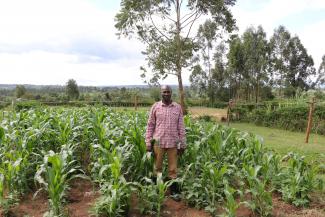September 2017—Stanley Kimeli has seen his harvest double since joining a local youth group in western Kenya called Kilima Tumaini, or Mount Hope. With only a primary school education, he did not know how to farm profitably before joining the group in 2007.
Although the region is known as the breadbasket of Kenya, local small-scale farmers like Kimeli have not always had the resources or opportunities to compete with larger growers in major commercial agricultural markets.
With USAID support, the U.N. World Food Program (WFP) trains groups of small-scale farmers in Kenya to boost their production, minimize post-harvest losses, and improve their marketing skills through market mapping and targeting. Across western Kenya, WFP is currently training nearly 10,700 farmers in 79 organizations to improve their production and connect to markets.
Kimeli, a 35-year-old father of three, is one of the 30 members of the Mount Hope youth group who now grow sufficiently high quality maize to meet international standards, thanks to WFP training, which began in 2011.
“I'm not educated. But I have learned hands-on skills that have given me a better life,” he says.
Kimeli inherited a small section of his father’s land to grow maize and beans for subsistence, but he has since bought a 2-acre piece of land and is leasing another 5 acres to increase his production. He also bought a farm tractor and chainsaw, which enables him to employ laborers; he can also lease the tools to other farmers for additional income.
“Before joining this group, I would only harvest 11 bags of maize per acre. Now I harvest an average of 20 to 25 bags per acre,” says Kimeli.
With the earnings from his production, he is paying for his children’s education and supporting his wife through college. “I asked my wife to advance her education,” Kimeli says. “I did not get that chance, and I want my children to have a role model.”
Members of the Mount Hope youth group combine their maize production from 400 acres and sell in bulk to WFP and the Kenya National Cereals and Produce Board, fetching a higher price than if they sold their harvests individually. But the positive impact does not stop there.
With support from USAID, WFP uses the purchased maize to feed vulnerable communities in drought-prone regions of Kenya. So far, WFP has bought more than 7,000 metric tons of cereals from farmers like Kimeli to help food insecure Kenyans with emergency assistance. WFP is helping to improve the overall food security situation by connecting smallholder farmers to markets.
Humanitarian needs are growing in Kenya—an estimated 3.4 million people are food insecure and malnutrition is on the rise as drought conditions persist. USAID, WFP and other partners are helping Kenyans to withstand the current drought and continue to build resilience to future shocks. Since October 2016, USAID has contributed more than $24 million to WFP to support approximately 1.4 million Kenyans with food assistance.
LINKS
Follow @USAIDKenya, on Facebook, on Flickr
,“I'm not educated. But I have learned hands-on skills that have given me a better life.”

WFP/Kenya
